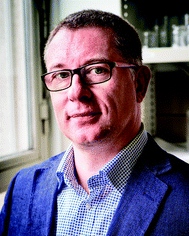A new scope for JAAS!
Frank
Vanhaecke
Department of Analytical Chemistry, Ghent University, Ghent, B-9000, Belgium. E-mail: frank.vanhaecke@UGent.be
As a variety of characteristics, such as toxicity, bioavailability and mobility, depend on the chemical form in which an element occurs, elemental speciation, for one, has become a widely studied topic. To maximize the information available, chromatographic separation systems are nowadays coupled in parallel to complementary analytical techniques providing both elemental and molecular information. Ionization sources can be tuned to provide either elemental or molecular information and X-ray absorption can be relied upon to reveal the electronic environment of a target element (its oxidation state) directly in a solid sample.
Meanwhile, also in other fields of application, the difference between atomic and molecular spectrometry has become less evident. In quadrupole-based mass spectrometry, collision/reaction cells have been adopted as a standard tool to overcome spectral interference. Especially with the introduction of tandem ICP-MS, more and more commonly, it is the target ion that is originally subject to spectral overlap that is engaged in a selective reaction with a gas molecule and thus converted into a polyatomic or molecular ion that can be measured interference-free at another mass-to-charge ratio. Also in AAS, molecules are more often monitored; for the determination of non-metals, the element of interest is converted into a molecule in the graphite furnace and the extent of molecular absorption is monitored in an approach referred to as continuous source molecular absorption spectrometry (CSMAS). Finally, for decades now, the isotopic composition of C and O in a sample has been unravelled using gas source isotope ratio mass spectrometry to monitor the intensities of the ion beams of CO2+ ions with different molecular masses.
In contrast, in time-of-flight atomic mass cytometry, antibodies labeled with rare earth element (REE) nuclides are used to specifically identify and quantify antigens occurring in individual cells. As a result, exactly the opposite approach as described in the previous paragraph is applied: an elemental ion – that of the REE nuclide considered – is used to provide information on a complex biomolecule.
There is a thin line between atomic and molecular spectrometry nowadays…
The wide use of engineered nanomaterials also brings about new analytical challenges, not only for quality control purposes, but also for studying their fate once released into the environment or taken up in the body, while analytical approaches once typical for a limited research field only (e.g., isotopic analysis of metals in geo- and cosmochemistry) are nowadays successfully used in alternative contexts (e.g., in a biomedical context).
All of these considerations provided the Editorial Board with a strong incentive for re-evaluating the scope of the journal to include novel directions without losing the valued identity of the journal. Lively discussions at subsequent meetings led to the following description:
“JAAS is the central journal for publishing innovative research on fundamentals, instrumentation, and methods in the determination, speciation and isotopic analysis of (trace) elements within all fields of application. This includes, but is not restricted to, the most recent progress, developments and achievements in all forms of atomic and elemental detection, isotope ratio determination, plasma-based analysis and X-ray techniques.”
To further guide authors and referees, we have compiled a list of subjects that are considered “in scope”. The combination of “Molecular sources for elemental and isotopic analysis” and “Atomic sources for molecular analysis” reflects the fact that the boundary between atomic and molecular spectrometry has become very vague nowadays. The list also contains a number of terms that were simply unheard of when the journal was started in the eighties, such as immunoassays based on metal-labeled antibodies, bio-imaging, engineered nanoparticles and quantum dots, to only name a few. Also a list of the techniques covered is provided. It should be noted that the mere use of one of the techniques listed is not a sufficient condition for publication in JAAS, even if the work is of sound analytical quality. Eligible manuscripts should include a degree of analytical novelty and/or describe the use of the technique in a so far rarely explored and relevant context. All contributions are judged on originality and quality of scientific content, and appropriateness of length to content of new science.
However, perhaps even more important than the list referred to, is the accompanying sentence that “Submissions are welcome in those areas, but note this list reflects the current scope and authors are strongly encouraged to contact the Editorial team if they believe that their work offers potentially new and emerging research relevant to the journal remit.” This may seem an overly prudent description, but it reflects the intention of the journal to be aware of and be open to all types of progress in the field it covers and to present its readers with a wide and as complete as possible view on what is going on in our area of research.
We will encourage all our referees to bear in mind this evolution in the scope of the journal when considering articles during the peer-review process, and of course both authors and referees are invited to contact the Editorial office with any questions or comments.
We hope that the efforts of the Editorial Board will be well-received and that the journal and especially its readers benefit from the updated scope.
Frank Vanhaecke
| This journal is © The Royal Society of Chemistry 2015 |

